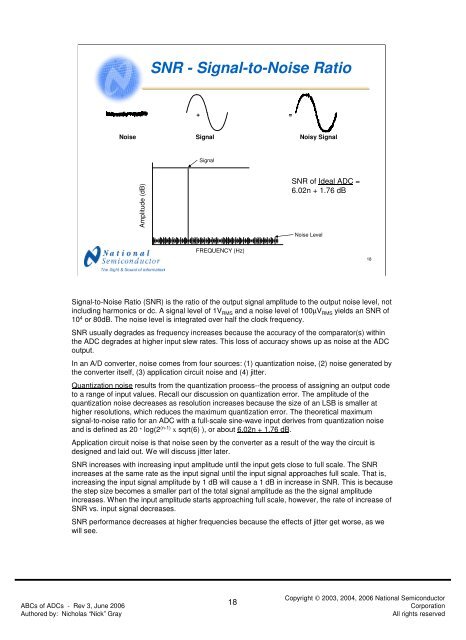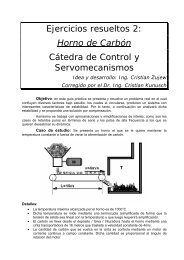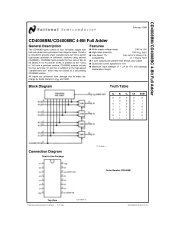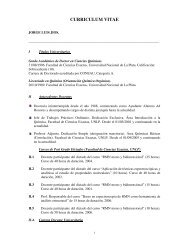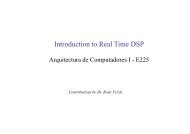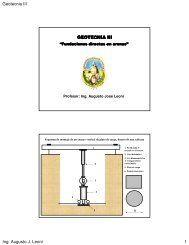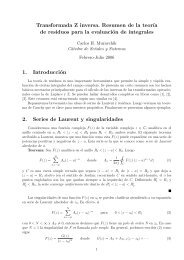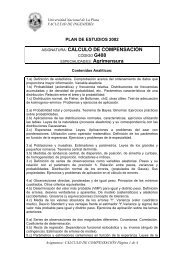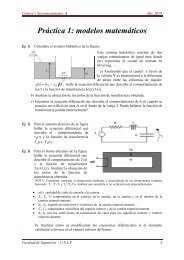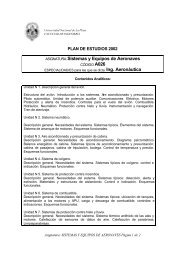ABCs of ADCs - Analog-to-Digital Converter Basics (PDF)
ABCs of ADCs - Analog-to-Digital Converter Basics (PDF)
ABCs of ADCs - Analog-to-Digital Converter Basics (PDF)
Create successful ePaper yourself
Turn your PDF publications into a flip-book with our unique Google optimized e-Paper software.
SNR - Signal-<strong>to</strong>-Noise Ratio+ =Noise Signal Noisy SignalSignalAmplitude (dB)SNR <strong>of</strong> Ideal ADC =6.02n + 1.76 dBNoise LevelFREQUENCY (Hz)18Signal-<strong>to</strong>-Noise Ratio (SNR) is the ratio <strong>of</strong> the output signal amplitude <strong>to</strong> the output noise level, notincluding harmonics or dc. A signal level <strong>of</strong> 1V RMS and a noise level <strong>of</strong> 100µV RMS yields an SNR <strong>of</strong>10 4 or 80dB. The noise level is integrated over half the clock frequency.SNR usually degrades as frequency increases because the accuracy <strong>of</strong> the compara<strong>to</strong>r(s) withinthe ADC degrades at higher input slew rates. This loss <strong>of</strong> accuracy shows up as noise at the ADCoutput.In an A/D converter, noise comes from four sources: (1) quantization noise, (2) noise generated bythe converter itself, (3) application circuit noise and (4) jitter.Quantization noise results from the quantization process--the process <strong>of</strong> assigning an output code<strong>to</strong> a range <strong>of</strong> input values. Recall our discussion on quantization error. The amplitude <strong>of</strong> thequantization noise decreases as resolution increases because the size <strong>of</strong> an LSB is smaller athigher resolutions, which reduces the maximum quantization error. The theoretical maximumsignal-<strong>to</strong>-noise ratio for an ADC with a full-scale sine-wave input derives from quantization noiseand is defined as 20 * log(2 (n-1) x sqrt(6) ), or about 6.02n + 1.76 dB.Application circuit noise is that noise seen by the converter as a result <strong>of</strong> the way the circuit isdesigned and laid out. We will discuss jitter later.SNR increases with increasing input amplitude until the input gets close <strong>to</strong> full scale. The SNRincreases at the same rate as the input signal until the input signal approaches full scale. That is,increasing the input signal amplitude by 1 dB will cause a 1 dB in increase in SNR. This is becausethe step size becomes a smaller part <strong>of</strong> the <strong>to</strong>tal signal amplitude as the the signal amplitudeincreases. When the input amplitude starts approaching full scale, however, the rate <strong>of</strong> increase <strong>of</strong>SNR vs. input signal decreases.SNR performance decreases at higher frequencies because the effects <strong>of</strong> jitter get worse, as wewill see.<strong>ABCs</strong> <strong>of</strong> <strong>ADCs</strong> - Rev 3, June 2006Authored by: Nicholas “Nick” Gray18Copyright © 2003, 2004, 2006 National Semiconduc<strong>to</strong>rCorporationAll rights reserved


